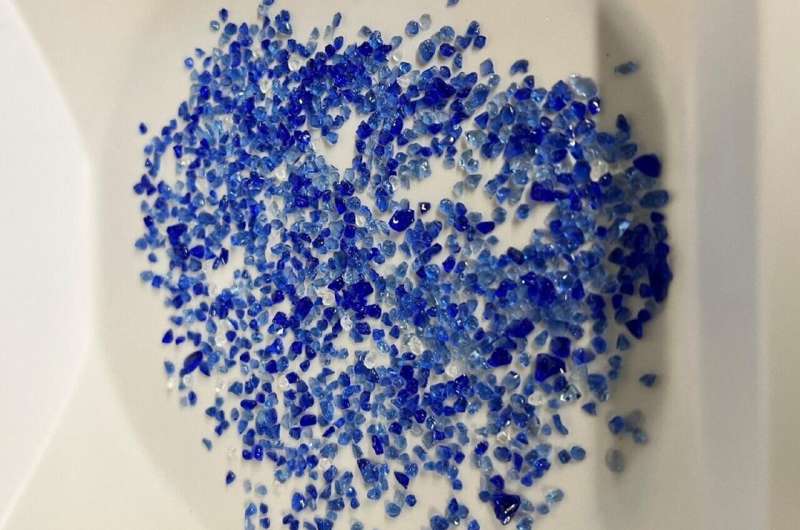This article has been reviewed according to Science X's editorial process and policies. Editors have highlighted the following attributes while ensuring the content's credibility:
fact-checked
trusted source
proofread
Message in a bottle: Combining mixed-color glass an option to boost recycling

The glass bottles we toss in the recycling bin don't always end up where we expect. Only about 33% of glass is recycled in the United States, according to the Environmental Protection Agency, partly due to expenses like sorting bottles by color. Penn State scientists recently found that mass-produced soda-lime silicate glass from post-consumer bottles of different colors can be safely melted together in the recycling process, which could potentially lead to more bottles being recycled.
The team reported their findings in the International Journal of Ceramic Engineering & Science.
"This work broadly addresses a widespread misconception that different colored glassbottles can't all be recycled together," said Katy Gerace, who conducted the research as a doctoral student in the Department of Materials Science and Engineering at Penn State. She graduated in 2023. "We have confirmed that you can melt all these post-consumer glass bottles together to create new, useful glass products."
Soda-lime silicate bottles, the most recycled type of glass, are turned into cullet—glass that has been crushed into small pieces, or grains—before being remelted. Cullet is most often sorted by color so that manufacturers can achieve specific color and clarity for their products. And the availability of pristine, color-sorted glass cullet limits how much recycled material is used in the manufacturing process, the researchers said.
Small-scale manufacturers who are focused on recycling, and not on achieving a specific color bottle could utilize mixed-color cullet, keeping more glass bottles out of landfills and reducing energy costs associated with manufacturing glass, the scientists said.
Remelting glass cullet requires less energy than raw materials, which translates into less carbon dioxide produced during the melting process. For a 10% increase in recycled content, the scientists said, there is a 3% reduction in energy consumption.
"We are exploring how to add value to waste," said Gerace, who is now a research and development senior engineer at Vitro Architectural Glass. "We are trying to think of this not as waste but as something that potentially could have value."
The work stems from a partnership between Penn State and Remark Glass, a Philadelphia-based company focused on innovative and creative glass recycling.
"As a small business, they are really interested in trying to remove glass from the waste stream and keep it out of landfills," said John Mauro, the Dorothy Pate Enright Professor of Materials Science and Engineering at Penn State and co-author of the study.
"They use only post-consumer glass bottles and so they are very interested in understanding the chemical and material properties of the raw materials that come into their business. They wanted to know if there were any technical reasons for them to be concerned about what they're doing."
Remark Glass provided glass bottles for the study, and Gerace analyzed the samples for chemical composition and thermal properties to quantify variation across five major color families: clear, blue, amber, forest green and emerald green.
In addition to demonstrating that post-consumer bottles of different colors and brands can be remelted without risk of material incompatibility, the researchers also presented various processing methods to control color homogeneity in glass produced exclusively from mixed color cullet from recycled glass bottles.
Gerace said the particle size of the cullet and the temperature and time of the remelting process have the biggest impacts on color homogeneity.
"You have to keep the glass melted for all the different ions to diffuse and move around to create a consistent color," she said. "So, you can either really extend the time of the melt and hold it at a high temperature for a long time to wait for everything to kind of equilibrate or you can decrease the particle size of the cullet into more of like a fine powder. Then it becomes a little easier to get a nice consistent color."
This means, for example, that various shades of green bottles could be crushed into cullet and melted to produce a homogenous green glass. However, if a specific shade of green is required, then the bottles would be further separated.
"Glass is one of the best materials to recycle, but when you actually go look at the process for how it's done, it's very non-trivial," Gerace said. "And unfortunately, we lose a lot of what we put in our recycling bins to the landfill simply because we don't have a good way of separating and sorting it. And that's really unfortunate."
More information: Katy S. Gerace et al, Characterization of soda–lime silicate glass bottles to support recycling efforts, International Journal of Ceramic Engineering & Science (2024). DOI: 10.1002/ces2.10217
















